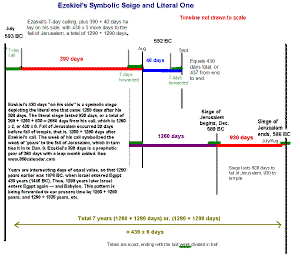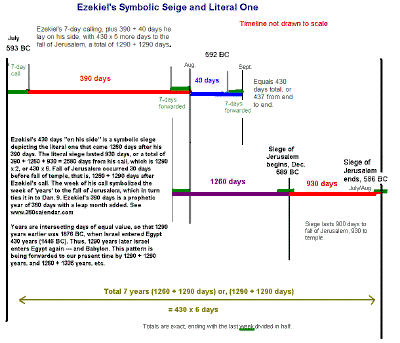Patterns derived from the above chart:
The Exodus occurred in 1446 BC. Israel had spent 430-years in Egypt. They arrived at Mount Sinai on day 60 ending (or day 61), which therefore symbolizes AD 60. It happens that 430 days later Israel attempted to enter the Promised Land after 40 days of spying out the land. But they failed to enter the Promised Land at that time. That was the 490th day from the inaugural year of 1446 BC, which then symbolized AD 490. (AD 60 + 430 days/years = AD 490). Thus after 430 years in Egypt, they arrive at Mount Sinai, and after 430 days more, they attempted to enter the Promised Land. Thus 430 years intersects with 430 days (see Ezek. 4) "a day for each year." But more than that, symbolic AD 60 is 3½ x 430 years from literal 1446 BC, and thus 490 is 4½ x 430 years. Since Abraham entered the Promised Land from Babylon 645 years before the Exodus in 2091 BC, thus from literal 2091 BC to symbolic AD 490 are 6 x 430, which is also 1290 x 2 years. (Moreover, 490 is the number in Daniel 9.) Click here for the key epoch events in the bible and their dates.
For example, 430 x 2 years after the Exodus was the the fall of Jerusalem when Judah went back into exile to Egypt and Babylon. (This means that from the time they entered Egypt in 1876 BC until the time they entered again into Egypt in 586 BC are 430 x 3 years, or 1290 years (of Daniel 12).
The events and prophecies of the book of Ezekiel occur at the time of the fall of Jerusalem. He began his symbolic siege of Jerusalem 1290 x 2 days before the literal one fell. (Ezek. 4). He was told to symbolically siege Jerusalem 430 days, (390 + 40 days; compare this to the 450th and 490th day of the above chart). Thus, Ezekiel besieged Jerusalem one-sixth of the 1290 x 2 days (since 1290 x 2 = 430 x 6).
The literal siege of Jerusalem by the Babylonians (that Ezekiel earlier had acted out) began 800 days before the New Year of 586 BC (430 x 2 years after the inaugural year at the Exodus in 1446 BC). (All day counts are according to the 360-year calendar of the prophets.) Ezekiel also dates the temple chapters in Ezekiel 40:1 by this New Year of 586 BC. In a sense, the New Year of 586 BC was therefore also anther inaugural New Year that began a new count of reckoning the years (just as the exodus has been.) Thus, 800 days before the New Year of 586 BC creates the symbolic year of 801 BC. (It is not 800 BC, since there is no such thing as the year zero. Thus between 1 BC and AD 1 are just one year and not two years.) thus, the siege of Jerusalem by the Babylonians began in the symbolic day/year of 801 BC in the literal year of Dec. of 589 BC. It happens that 801 BC also intersects with the 430-year cycles spoken of earlier! For instance, 801 BC less the symbolic 430 x 2 day/years = AD 60 (the symbolic day/year at the time of the Exodus a literal 430 x 2 years earlier! Or, to AD 490 is 1290 day/years (430 x 3), which is the figurative date as seen in the earlier example (of when they attempted to enter the promised land), but a literal 1290 years earlier was 1876 BC, when they entered Egypt 430 years. Thus the 430 days of the between symbolic AD 60 and AD 490 are again being emphasized by a chiastic numeric. (That is, 430 is being overlapped twice by the intersecting of literal years and days of equal value, that intern run along a symbolic day/year grid that also intersects the same!) All this is complex at first reading, but rather simple after a few days at it.
Ezekiel records the arrival of the first exiled person from Jerusalem to Babylon on a day that was 275 days after the New Year of 586 BC. Thus, that day symbolized AD 275. The year AD 275 also falls along the 430-year cycles. For example, 430 years after literal 586 BC of the fall of Jerusalem is AD 275--- and so forth.
But what about the date of Ezekiel's 430 day symbolic siege. Surely it would especially bring forth consistent and important dates that follow this pattern so as to show us that this is no mere chance. And so it does!
The 430-days of Ezekiel's siege "a day for each year" began 7 days after his call. For seven days he sat overwhelmed at the revelation of God. This seven days symbolized the next literal seven years that would elapse before the actual fall of Jerusalem. (1290 x 2 days is seven years, or seven years and one month.) (390 days is 360 days with a leap month added, the number in Ezek. 4. Notice that the two creation dates are 4300 and 3900 years before the birth of Christ --- ten times the span of years given us by Moses and Ezekiel.)
Ezekiel was called of God (seven days before he began his 430-day/year siege) 2425 days before the New Year of 586 BC. Thus that year symbolized as 2426 BC. This date is a mirror number. That is, 2426 in AD rather than BC falls along the 430 year cycles. For example, 1876 BC (when Israel entered Egypt 430 years) plus 4300 years equals AD 2425. Thus, the 430-days that Ezekiel lay on his side symbolically besieging Jerusalem also intersects with these numbers, but in a way more amazing then first meets the eye! They were in Egypt 430 years. Moses sought to deliver them 40 years earlier when they had been 390 years in Egypt. Moses failed and himself went into exile 40 years until his call at the burning bush in the autumn of 1447 BC. This is the same numeric pattern found in the dates at the exodus as seen in the above chart and it is also the pattern that Ezekiel gives us (of 390 + 40 = 430 days and years). It is also the pattern, as said, at creation, of 3900 and 4300 years to Christ. Here is how it all works!
The symbolic date at the call of Ezekiel, we are told, was 2425 days before the inaugural New Year in 586 BC. That day, as said, therefore symbolizes as 2426 BC. However, by now the astute reader should be asking two questions. What about the leap month that occurs every 6 years or so (see www.360calendar.com), and what about the other dating method Ezekiel uses throughout his book, namely as from the year of his own personal Exile to Babylon that occurred 11 year earlier so that the New Year of 597 BC is also an inaugural year?
God is awesome!
First we answer the first point!
It is true that the year of Ezekiel's call can be seen as 2426 BC or 30 days more (due to the leap month) as 2456 BC. But this is perfect in every way!
For example, we saw that 2426 BC plus 4300 years = the mirror of 1876 BC, when they entered Egypt. However, 2456 BC plus the said 3900 years = the mirror of 1446 BC, when they left Egypt at the exodus! Or, if you would, the 2456 BC, less the 430 days of Ezekiel's siege equals 2026 BC. This less 3900, therefore, equals the mirror of 1876 BC ---when they entered Egypt. And so forth. It is even more complex than this but that is enough for now. (In passing, we are concentrating on the 430-year cycles, but what of the 490 cycles of Daniel 9? 2426 BC plus 490 x 2 = 1446 BC, the exodus! and therefore see to Christ at birth and at 30 years of age when He began His ministry. We have 5 x 490, or 50 Jubilees, etc.)
Now onto the second problem! (And there is a third, namely, the seven days before the 430 days of Ezekiel's siege.)
We said showed quickly that Ezekiel dates his prophecies by both the New Year of spring of 597 and 586 BC, which are 11 years apart. This means that whatever dates we have shown so far for Ezekiel can also be forward 11 years of years. There are 4020 days in an 11 year period. (11 x 360 = 3960, plus the two leap months that occur during such a span = 4020 days. This means that the dates of 2426 (2456) BC and plus the 430 days of Ezekiel's' siege, 1996 (2026) BC, can be forwarded by 4020 day/years. So let us do that!
(His call) 2426 (2456) BC plus the said 4020 day/years = AD 1595 (1565).
(His siege) 1996 (2026) BC plus the said 4020 day/years = AD 2025 (1995).
The first thing you should notice is that the siege dates repeat themselves in each others mirror!!! (Note color code.) Also, all four dates underlined fall along the 430 year cycles. The one day/year difference is intentional since this allows an exact 3900 years from 1876 BC to AD 2025, or 1290 x 3 (430 x 9) to 1876 BC from AD 1995.

